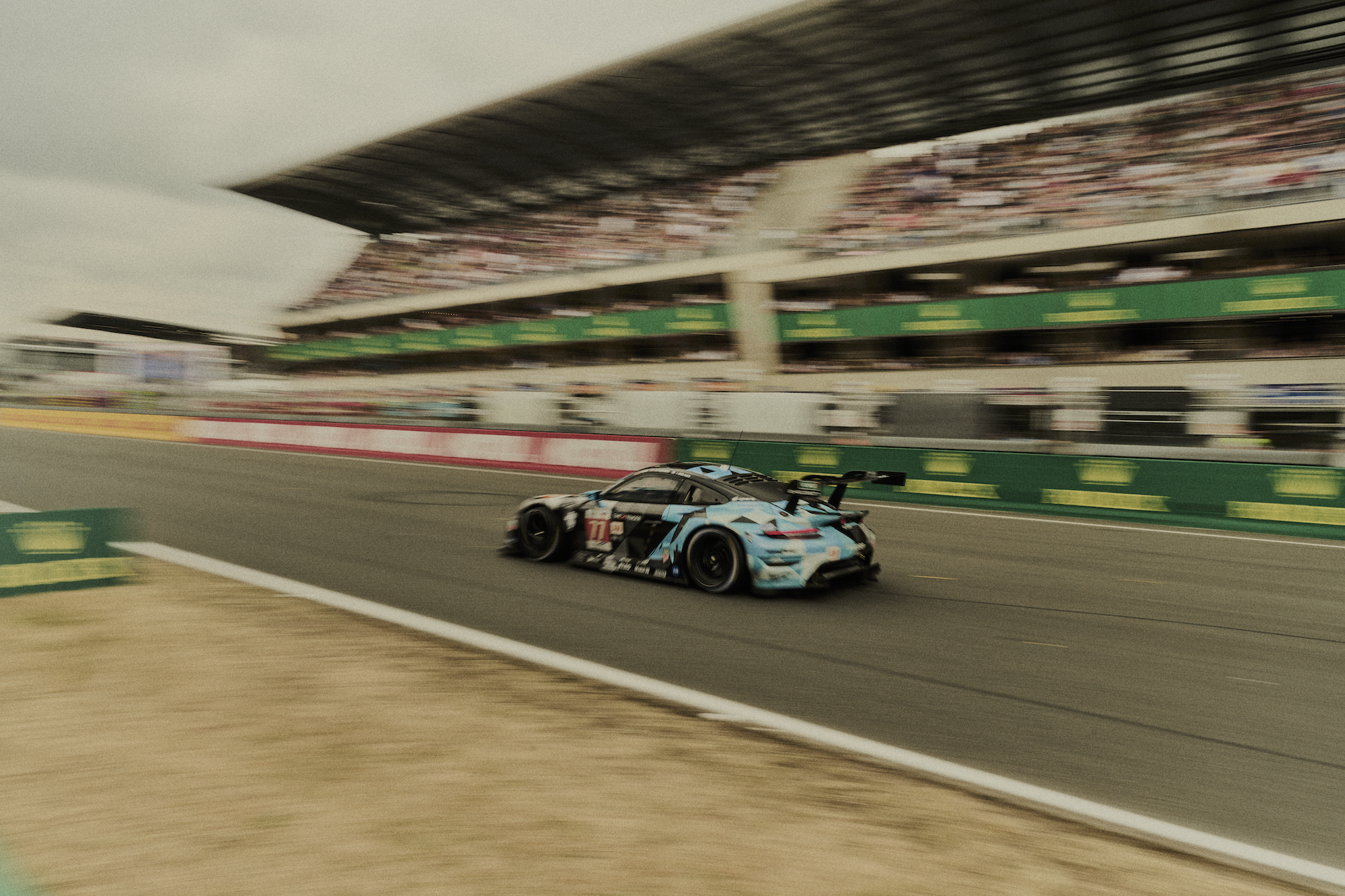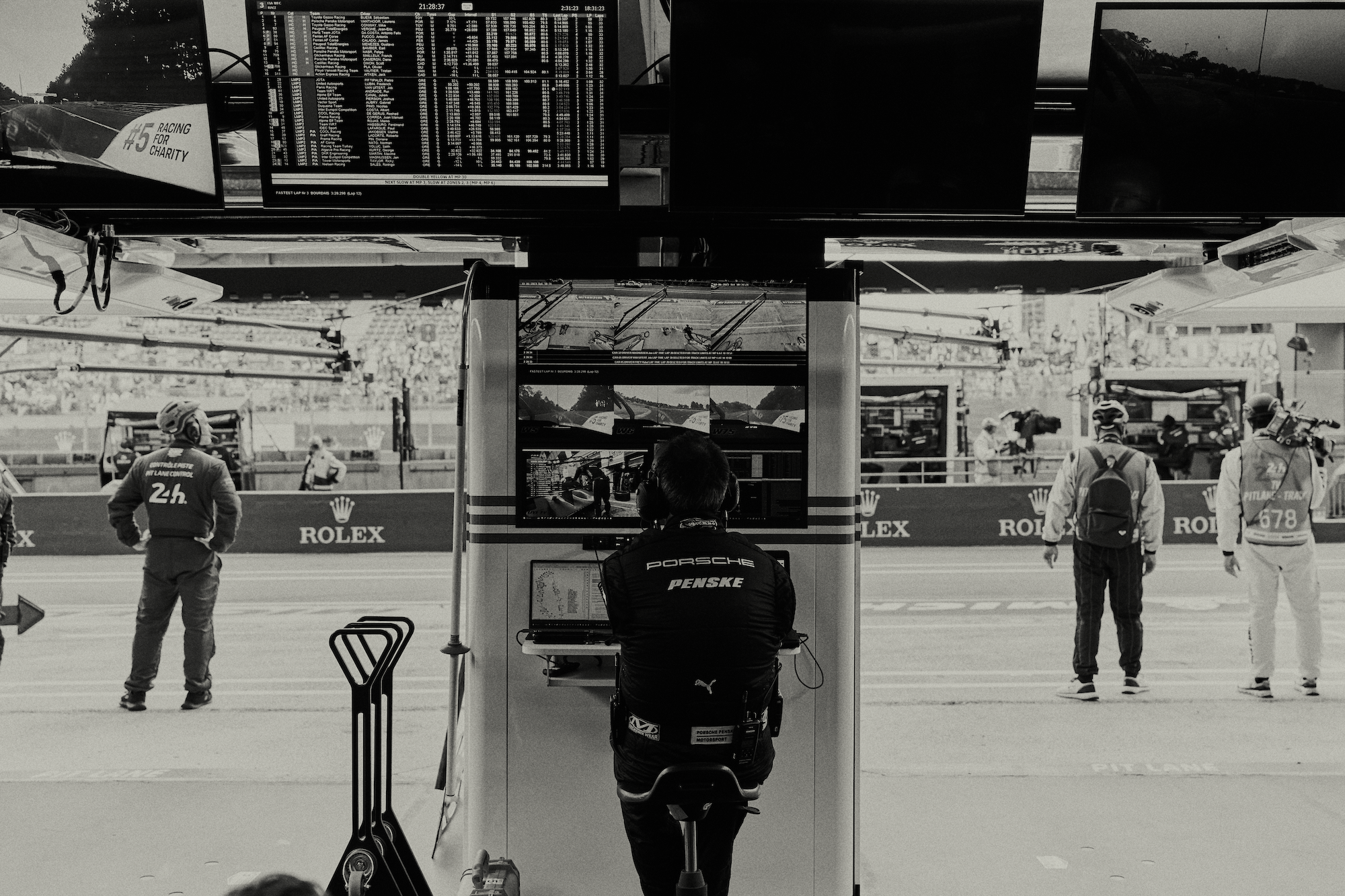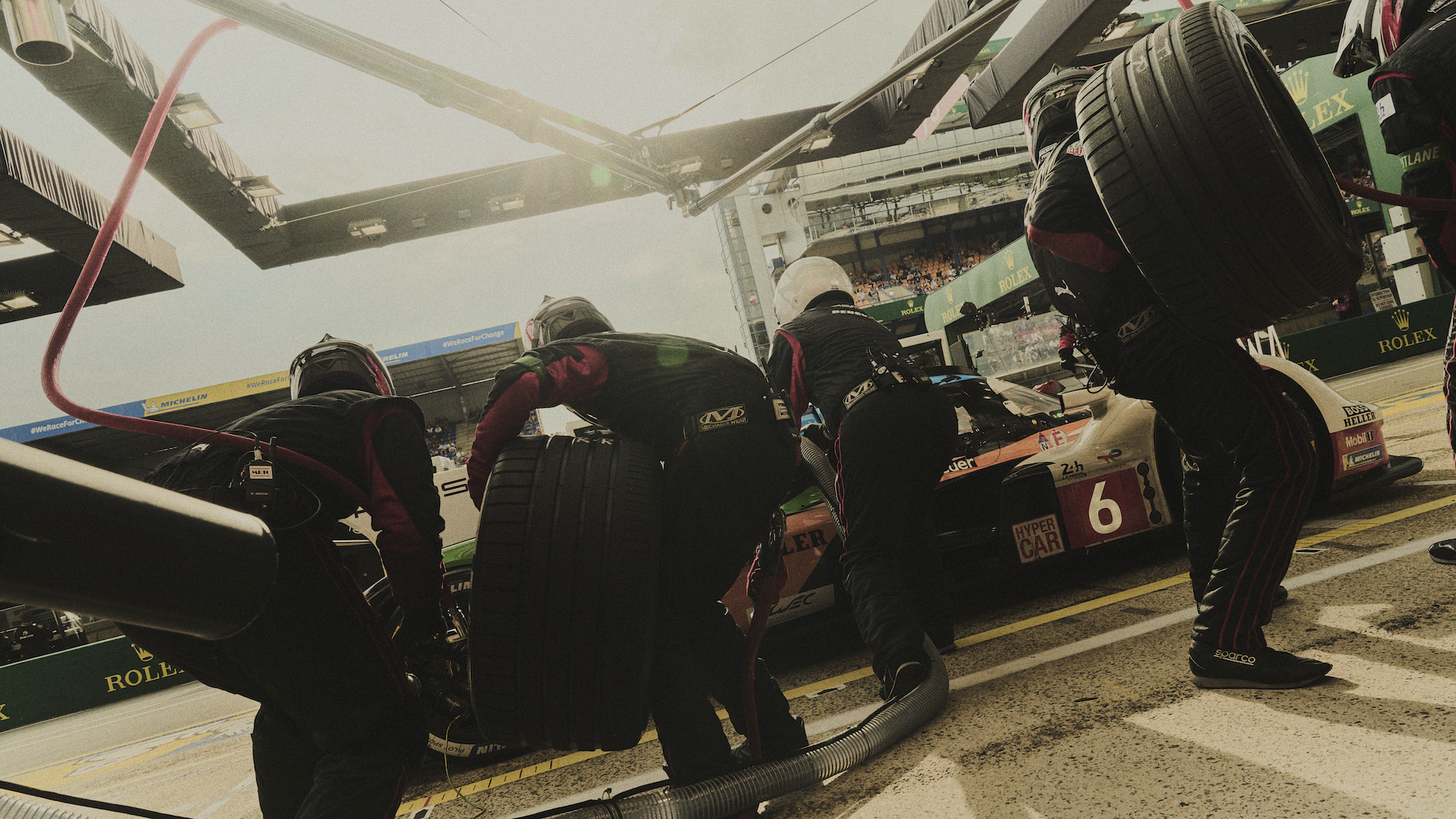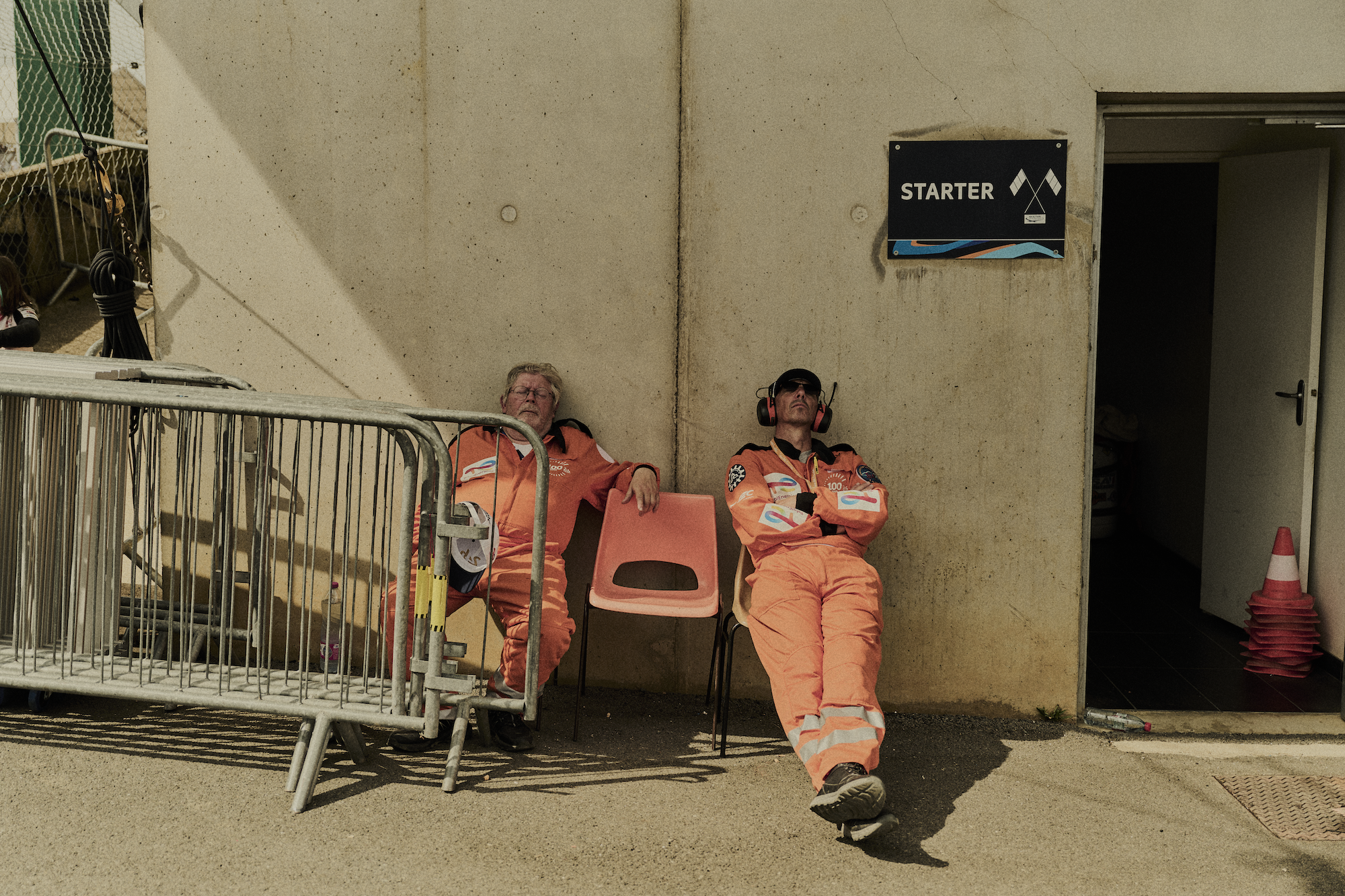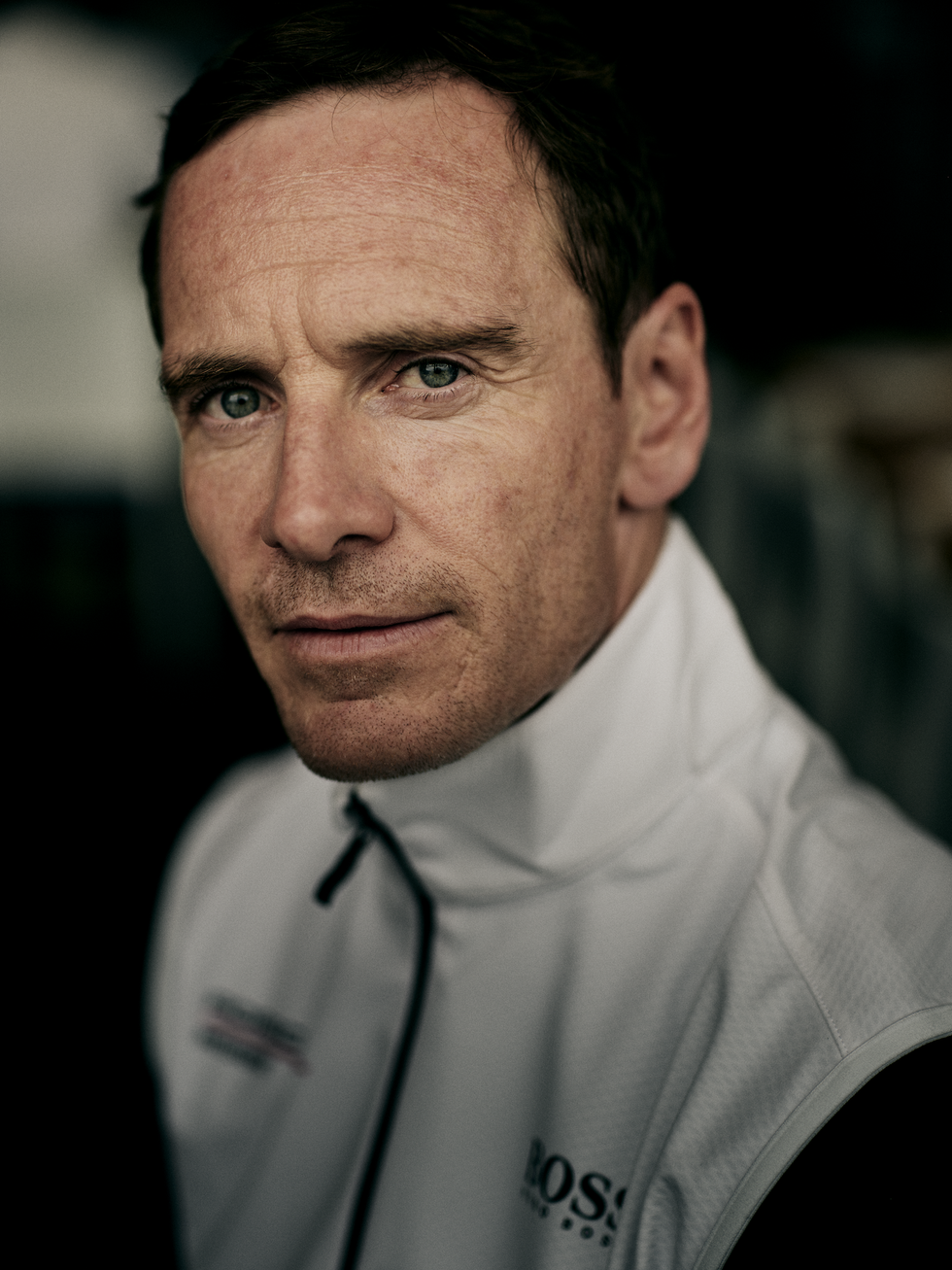SUNDAY 11 JUNE 1.12AM
A sultry night. The centenary staging of Le Mans, the iconic 24-hour motor race held annually in northwestern France, has been running for just over eight hours. The mechanics of the Porsche Penske Motorsport team are asleep, stretched out on folding chairs beneath the operating-theatre glare of the garage. Outside, the pit lane is quiet. The silence will last for three minutes until the 50-odd entrants in the race, currently held behind the safety car, scream down the start/finish straight in a deafening strobe: Porsche 963 hypercars trailing red Tron-like brake lights, a salvo of 911s, scudding Chevrolets, Ferraris, Toyotas, LMP2 Orecas and Alpines, Aston Martins, the crazed firecracker of the lone Nascar blaring then fading as the train disappears toward the Dunlop chicane.
Even slowed up in a yellow-flagged holding pattern, the speed and noise of the cars is terrific. Funnelled by the grandstands, the pressure waves wham into eardrums and chests. Yet the Porsche pit team doze through it, apparently dead to the maelstrom. Then a word in a headset and eyes flash open. The crew stand, stretch; chairs are cleared. Something has happened out on track. The race management and telemetry team sit frozen, tense at the back of the room. Monitors show headlamps jostling on the shoulder of the pace car, shooting stars on the Mulsanne straight.
Three Porsche Penske hypercars are currently out on track — numbers 5, 6 and 75 — each worth around €2.8m. The elite class at Le Mans this year, the highest-performing supercars in the world, each machine is driven by a set of three drivers who pilot in rotation throughout the 24 hours, pitting for fuel every hour, tyres every couple. But this feels different. Something’s gone wrong.
Several overalled mechanics rush past me. Tools are gathered, people reappear with kit: tubes, pumps, oil trays. Hypercar number 5 snaps to a halt outside and its insectoid silhouette is immediately obscured by a synchronised swarm of mechanics. Jacks hiss, the piercing ratchet of wheel guns — up it goes, in it swings, driver still inside. Drills buzz — tail off, rear cowling off, everything placed exactly to the side — the innards revealed as a sci-fi conglomerate of vents, rods, conduits; springs, gills and mesh. Men in balaclavas slide underneath. Floor panels off — the garage is fiercely hushed, the in-ear monitors making the operation seem telepathic. The air smells of oil and hot metal. Furious tension. Fluid on the floor of the pristine garage. A word, the engine roars. Another word, it stops. Another inspection. Floor and body panels back on. New tyres. Wheel guns blare. They bobsleigh the car out, it pirouettes 90 degrees. Hiss, down, gone. The crew start scrubbing the floor.
“Can I ask you what just happened?” I say to a mechanic. He winks, shakes his head.
“Car number 5 had a leak in the cooling system,” explains Rebecca Jones a little later. Team Comms for Porsche Penske Motorsport, all officially worded press goes through her. We’re talking in an office behind the pits, the florescent light sheens on our skin. Even at 2.20am the heat is soupy. “They took it all apart. Some pipework needed changing. A 23-minute repair.”
In the garage, the mechanics are sleeping again. Below us, drivers drowse or prepare to take the wheel. The safety car pits, the race restarts, the concertinaed field speeds up and spreads out.
Fourteen hours to go.
Together with the Monaco Grand Prix and the Indianapolis 500, the 24 Heures du Mans forms part of the Triple Crown of Motorsport. The race depicted in Steve McQueen’s 1971 movie of the same name still manifests each June just outside the city of Le Mans, on the Circuit de la Sarthe: a unique mix of public roads and purpose-built track. As a contest, it’s a strange combination of box-office spectacle and niche endurance slog. This year, at 4pm on 10 June, basketball legend LeBron James waved the roaring field off with a tricolore delivered by a military helicopter and Dua Lipa sprinkled stardust on the paddock. At 4am a hardy handful of spectators are still huddled in sleeping bags, watching cars pass from high in the grandstand. Same race, 12 hours apart — all the glitz having peeled away to reveal fatigue and grit.
Established at a time when short-form Grand Prix racing already dominated, the Le Mans 24-hour race encouraged innovation, testing manufacturers’ ability to build fast, reliable cars. Unlike Formula 1, the aim is not to take the least time over a fixed distance, but to cover the greatest distance over a fixed time. The car that wins is the one that spends the most time on the asphalt, the least in the pits. In this hybrid age where batteries
combine with combustion engines, and state-of-the-art cars run on renewable fuel made from grape marc and lees — waste from wine production, perhaps the Frenchest fuel ever known — efficiency, composure and stamina are still the keys to victory, just as they were in 1923.
“Your car is running or it’s fucked,” half-jokes a driver, moments before the race begins. “You’re either on the road or in the wall.”
All kinds of people come to try their luck here: former F1 drivers, Nascar stars, professionals and amateurs from all over the world. Men and women compete side by side. This year, the Iron Dames — an all-female team created to promote women at every level of motorsport: driving, engineering, management — are competing for a podium place. This is exceptional. Le Mans, like most racing, is a very male space of pros and “gentleman drivers” with deep pockets. Historically, the main exceptions have been actors and artists drawn to the glamour and chance to compete.
“Focus and precision are two things that cross over [between acting and racing],” the actor Michael Fassbender tells me in the Porsche compound ahead of his second Le Mans. “That ability to just allow things to happen. Being awake and aware, and relaxed.”
Fassbender, well known for his work with the other Steve McQueen, the revered British artist and director of Hunger and 12 Years a Slave, is driving in the GTE-Am category (Grand Touring Endurance-Amateur). This means that his 911 RSR-19 is one of 21 cars that will spend much of Le Mans’ 24 hours being overtaken by pros in hybrid beasts, but he doesn’t seem to mind. “Being out on track with some of the best drivers in the world — it’s kind of crazy,” he says. “And the town itself, and the fans that come here, the passion they have, their love of motorsport. There’s 350,000 people or so here. It’s pretty amazing.”
Echoing Fassbender, independent driver Ben Barker of GR Racing describes Le Mans as a mix of focus and flow. “It’s so intense. The lights are the biggest thing: in the mirrors, just glaring, so you can’t judge distances to other cars at all. But when you get a clear bit of track, it’s just you. I’ll just be in a rhythm. And you go through sections with no floodlights, but you can see the silhouettes of the crowd lining the banks and you think, ‘Oh, my God, they’re still here, they’re still going.’ And then you’ll come across a really intense battle, a dogfight: out of nowhere it suddenly ramps up; so you do that for two laps, and then it chills out again and you can’t see anyone and it’s quiet.”
“Le Mans is like driving with the lights off,” says Mark Webber, the Australian former F1 driver who has raced here four times, finishing on the podium once — now back as a guest of honour for the centenary celebrations. “It’s proper night racing… a beautiful feeling. But it is quite amazing how alone you feel. I’ve had some of my biggest lows here in terms of leading quite a few times and not being able to finish the job — second in 2015 — but it really picks you to win. Of course, you need some luck, but also you need to be there at the right time and do the business.”
Drivers will repeat different versions of this axiom to me before, during and after the race weekend: without luck, you can’t win Le Mans.
The race is often won in the lonely, uncanny hours of darkness. Porsche driver Nick Tandy, who beat Webber to first place in 2015, in large part thanks to a famously fast four-hour shift in the car overnight, describes night driving as “hard”, then pauses. “I don’t quite mean that. It’s not harder, but it’s easier to make mistakes.” The dream is to start in daylight and drive into the night, “to start with your normal visual references and then gradually adapt as it gets darker”. Much more difficult is to go straight out from an arc-lit pit lane to a track that’s completely black. “And it takes one or two or three laps to become comfortable… It’s like driving in the wet,” he grins, “you can be very good at it, but that doesn’t mean you like it.”
SATURDAY 10 JUNE. 6.55PM
Three hours into the 2023 race, rain begins to fall at the Porsche Curves — a sweeping right-left complex towards the end of the circuit. One of the quirks of a track this size is that one half can be bone dry and the other half a monsoon. Tyre changes cost time. The pits might be miles away. Stick or twist? Most teams opt to stay out on slicks, gambling that the rain will stop. The rain increases.
Five cars arrive at the curves at speed and hit standing water. An Oreca aquaplanes straight across the track. A Glickenhaus Hypercar thrashes and fishtails before having its nose clipped by a careening Ferrari — a red blur, hurtling backwards, out of control. Seconds later a Cadillac spins to a stop mid-track. A GTE-Am Porsche smacks into the rails, caving in its rear. The safety car is deployed. Those who can, limp back to the pits. Those who can’t, sit in their wreckage and blink.
The curves collect and crush the cars and hopes of drivers throughout the weekend. The 2021 Asian Le Mans Series champion Yifei Ye smashes his leading Jota Porsche into the barriers with such force it exposes the engine. With eight hours to go, Frenchman Kévin Estre’s fifth-placed 963 skims across a gravel trap and thumps flush into a tyre wall; four hours later Michael Fassbender misjudges an apex, skids across the kerbs and crumples his 911 into the Armco barrier, ending his race.
Le Mans has always had a harsh binary nature: day/night, win/lose, dream/nightmare. If 2023 is an annus horribilis for Porsche — their highest Hypercar places a disappointing 9th — for Ferrari it is delightful déjà vu: a victory exactly 50 years after their last appearance. Ben Barker finishes third in his class, his Instagram feed awash with champagne and delighted, exhausted faces.
An hour before the chequered flag, I approached Kévin Estre in the Porsche canteen. A tall, chiselled 34-year-old, known for his speed and courage on the track, he cut a sad, distracted figure. His race was run. He told me he felt he’d let everyone down. Having nursed his punctured car back to the pits, the repairs that followed put the race beyond reach. He described the seconds before the impact: low visibility, bugs on the windscreen, rubber marbles, oil and debris on the track. The manoeuvre that led to the crash was “optimistic but possible”. This is the man who once gained the lead at Nürburgring by overtaking a Mercedes at 277kph with two wheels on the grass. “It could have worked.”
For the next few weeks it will play on his mind, on loop — the moments before he hit the barrier, wrestling with the car to try to regain control, make it right. “When I close my eyes I will see it. But I will learn from it. I will not make the same mistake. Tonight I will have a few beers, try to forget.”
Then he rallied. “We learn, we move on. It’s my fault, but this is racing.”
